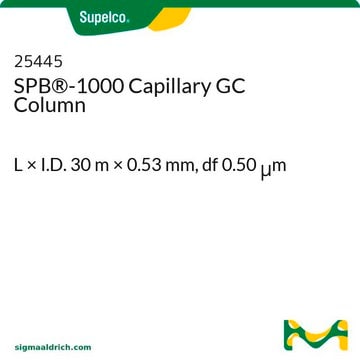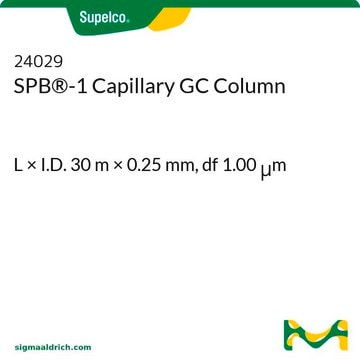24044
SPB®-1 Capillary GC Column
L × I.D. 30 m × 0.32 mm, df 0.25 μm
Sign Into View Organizational & Contract Pricing
All Photos(1)
About This Item
UNSPSC Code:
41115710
eCl@ss:
32119290
Recommended Products
material
fused silica
agency
meets requirements for USP G1, G2, and G9
parameter
-60-320 °C temperature (isothermal or programmed)
Beta value
320
df
0.25 μm
technique(s)
gas chromatography (GC): suitable
L × I.D.
30 m × 0.32 mm
matrix active group
Bonded; poly(dimethyl siloxane) phase
column type
capillary non-polar
Looking for similar products? Visit Product Comparison Guide
General description
Application: This column is often used for traditional general purpose applications, where a non-polar column is required. Analytes will be separated primarily according to boiling point.
USP Code: This column meets USP G1, G2, and G9 requirements.
Phase:
USP Code: This column meets USP G1, G2, and G9 requirements.
Phase:
- Bonded
- Poly(dimethyl siloxane)
- ≤0.32 mm I.D., <2 μm: -60 °C to 320 °C (isothermal or programmed)
- ≤0.32 mm I.D., ≥2 μm: -60 °C to 300 °C (isothermal or programmed)
- ≥0.53 mm I.D., <2 μm: -60 °C to 300 °C (isothermal) or 320 °C (programmed)
- ≥0.53 mm I.D., ≥2 μm: -60 °C to 260 °C (isothermal) or 280 °C (programmed)
Application
SPB®-1 Capillary GC Column was used for speciation of the nitrogen compounds (quantitatively), which are polar and somewhat basic in nature, with chemiluminescence detection.
Other Notes
We offer a variety of chromatography accessories including analytical syringes
Legal Information
SPB is a registered trademark of Merck KGaA, Darmstadt, Germany
Choose from one of the most recent versions:
Already Own This Product?
Find documentation for the products that you have recently purchased in the Document Library.
Yuming Cheng et al.
Langmuir : the ACS journal of surfaces and colloids, 34(21), 6117-6124 (2018-05-03)
Herein, an interesting light-induced self-assembly behavior from non-photoresponsive gold nanoparticles (Au NPs) was reported. Specifically, a pH-responsive amphiphile SPBwas developed that contained a particular phenylboronic acid moiety and showed excellent surface activity at the neutral and basic conditions, thereby stabilizing
S Hasnain et al.
Environmental pollution (Barking, Essex : 1987), 81(2), 179-184 (1993-01-01)
Five Pseudomonad strains, SPb-1, SPb-2, SPb-3, (from a water sample), SPb-4, and SPb-5 (from rhizosphere), which could tolerate lead acetate up to 1000 microm ml(-1), were isolated from an industrially polluted area around Kasoor, Pakistan. Only SPb-5 harbours a lead-resistant
Speciation of nitrogen compounds in gasoline and diesel range process streams by capillary column gas chromatography with chemiluminescence detection.
Birbal C
Journal of Chromatographic Science, 35 (3), 97-104 (1997)
Our team of scientists has experience in all areas of research including Life Science, Material Science, Chemical Synthesis, Chromatography, Analytical and many others.
Contact Technical Service





